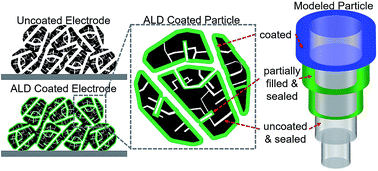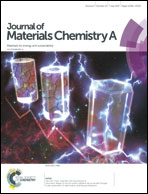Intrinsic limitations of atomic layer deposition for pseudocapacitive metal oxides in porous electrochemical capacitor electrodes
Abstract
By comparing the pseudocapacitive performance of ALD V2O5 in micro-, meso-, and macro-porous carbon electrodes, we describe the fundamental limits to ALD in very fine pores for pseudocapacitive charge storage. Comparing experimental trends with an ALD coating model, we find that the thermal V2O5 ALD process using vanadium triisopropoxide (VTIP) and water is unable to deposit in pores where the pore diameter is below a critical diameter of 13 Å. By adding the ALD V2O5 layer onto activated carbon electrodes, we find that the energy storage capacity could be increased by 144% for carbon with micropores and macropores, whereas for carbon black powder containing only macropores (i.e. a low surface area resulting in a relatively small starting capacity) the ALD coating increased the capacity more than 40-fold. To understand the ALD coating limits, the pores of the carbon electrodes were modeled as a series of connected tubes, and the volume of V2O5 deposited determined experimentally was compared to the calculated deposition limit. Pores below this critical diameter were sealed and decreased the accessible volume for V2O5 deposition by more than half, decreasing the maximum capacity. The effect of the pore sealing by the ALD process on the capacitive response of the activated carbon based electrodes was also studied. This work highlights the intrinsic capabilities and limitations of coating microporous materials using ALD.



 Please wait while we load your content...
Please wait while we load your content...